Should You Do Wall Sits If You Had Minicus Repair
Exercises later on meniscus repair
All about meniscus tears: Meniscus tear and treatment Beefcake:
The menisci are the wedge shaped cushion like discs (made primarily of type I collagen) that are sandwiched between the opposing thigh and leg bones. There are two menisci in the each knee joint, outer (lateral) and inner (medial). These menisci derive their nutrition primarily from synovial fluid (fluid that is present in the genu). Each meniscus has 3 parts namely a posterior horn, a body and an anterior horn. The inner meniscus is elliptical and larger in size than the outer meniscus which is more circular in shape and has the greater surface area.
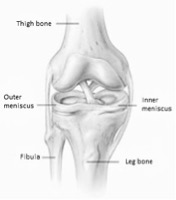
Why these menisci are of import: Menisci are elastic structures and they human activity as stupor absorbers in the genu joint and protect the joint cartilage (glistening surface of opposing thigh and leg bones). They are likewise important in keeping the thigh os fit into leg os. Menisci help in maintaining joint congruity and maximize contact area betwixt leg os (tibia) and thigh bone (femur).
What causes a meniscus tear?
In young patients meniscus tear are mostly due to twisting injury to the knee articulation. In old persons these are mostly due to age related degenerative changes. Abnormalities of meniscus like aberrant shape (Discoid meniscus) or meniscal cyst likewise make menisci more prone to injury. Inner meniscus is less mobile than outer hence tear of inner meniscus are more common.
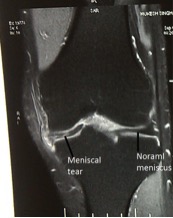
Can all meniscus tear exist repaired?
Only peripheral 10-25% width of menisci has blood supply. This outer or peripheral zone is known as red-red zone. Inner one/iiird width of menisci has no blood vessels. This is known equally white-white zone. In between these two zones (cherry-red-white zone) a few blood vessels may present. Only tears of red-red zone, and a few tears of red-white have healing potential and can be repaired. A majority of meniscal tears are nowadays in white-white zone and can't be repaired. All tears of white-white zone and most of the tears of red-white zone need resection.
Signs and symptoms: Hurting and recurrent swelling are common features. Oft a torn piece of meniscus entrapped in the joint gives a clicking sound and pain on knee bending as would occur in climbing upwards or down the stairs. At times, the torn part can be trapped in between the leg and thigh bones and may forbid leg bone from straightening. This status is chosen locking of the articulatio genus. A locked knee may require manipulation by the patient or the medico.
How meniscal tears are treated: Meniscal tears are diagnosed by clinical exam and confirmed by MRI. Fresh tears, minor tears and tears of peripheral cherry-red zone can be repaired. In meniscal repair torn parts are sutured together. Sometime tears, tears of white-white zone, degenerative tears and complex tears are commonly trimmed abroad. All meniscal surgeries are central pigsty surgeries and done arthroscopically (minimally invasive).
EXERCISE & REHAB
Rehabilitation after meniscus repair:
After meniscus repair you should not put weight on the operated limb for 4 weeks and your leg volition be kept straight in a knee brace. You should be away from sports activities (jumping, cut, twisting activities) for at least 6 months subsequently surgery. Utilize walker or crutches for walk.
Week one-2: you should apply ice every 2 hours for 20 minutes effectually operated articulatio genus for 1 week after surgery. This will help reducing edema and pain.
Exercises:
- Straight leg heighten exercises (lying, continuing): In lying down or continuing position lift the leg (with caryatid) yous desire to do up to 45 degrees. Hold it there for x seconds then echo with other leg. Do 10 times with each leg and repeat two times a twenty-four hour period.
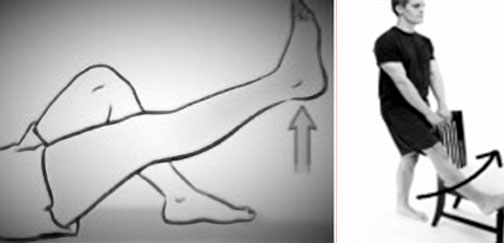
- Heel props: Place the heel on a rolled towel(without brace) and printing into it for 5 seconds so allow the leg to relax into extension for 5 seconds. Practice this practise every waking hour for 10 minutes. This helps to reach full extension (directly leg).

- Static quadriceps: In lying position proceed a rolled towel nether your human knee and push into it(without brace). Hold for x seconds and then relax for five seconds. Do three sets of 10 repetitions

You lot tin can walk with walker support simply don't put weight on the operated leg (don't touch operated leg with ground while walking in the first calendar month).
Week three-4
Keep all previous exercises.
- Hamstring stretches: push button your leg into chair as shown in the picture. Hold for the 10 seconds and echo for ten times. Exercise it twice a solar day.
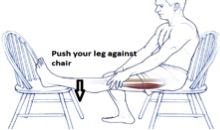
- Decumbent hangs to facilitate extension: lie downward on the burrow as shown in the pic, and keep the legs hanging at the edge of the table for 10 seconds. Repeat it for x times and do information technology twice a day.
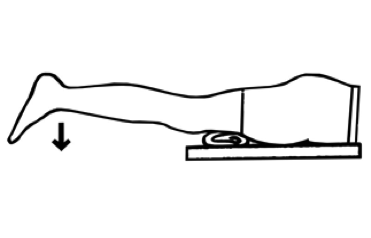
- Straight leg raise in lateral position: In lying downwardly position lift the leg (with caryatid) you lot want to exercise upward to 45 degrees. Hold it there for 10 seconds and so repeat with other leg. Do 10 times with each leg and ii times a twenty-four hours.
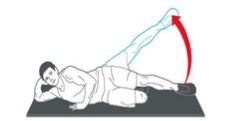
- Passive knee flexion (After 3 weeks): Remove caryatid and dangle your leg at the edge of the bed. Continue it there for a few seconds and and so utilise other leg to straighten up operated leg. In such way allow pain complimentary passive knee range of motion upward to 90 degree.

- Prone passive genu flexion (after 3 weeks): Apply a Thera band (an elastic band) as shown in the picture and flex the human knee in face up downwardly lying position. Bend your knee as much as you tin can. Hold for 30 seconds, and then release. Repeat iii-five times.

From weeks 3 onwards start passive genu flexion from 90 to 120 degrees. Y'all can use Thera band/rubberband band/Duptta to gain the flexion every bit shown in the picture below or when you hang the leg from the edge of the bed utilise push the operated leg with other leg to increase the range up to 120 degrees. Repeat x times and do information technology twice a day.
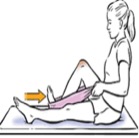

4-half dozen weeks: At present you wean off brace and start walking without brace. You can now put weight on the leg. You tin can go along using walker until you gain confidence to walk without support.
Continue all previous exercises:
- Heel raises/Toe raises: Concord for 5 seconds and slowly get down. Do it 3 times a mean solar day with ten repetitions each time.

- Active knee extensions: Sitting in a chair, slowly straighten your knee from 90° to xxx°, concord at 30° for several seconds, then bend back downwards to ninety°. 3 sets of 10 repetitions.


- Hamstring curls: Lying on your forepart. Bend your human knee up to 90° using your hamstring muscles. Slowly lower the foot to the floor again. 3 sets of 10 repetitions.

- Gastoc/soleus stretch: Lean towards a wall as shown in the movie and stretch your calf muscle. Don't let your heel come off the ground. Hold the stretch for fifteen seconds and repeat it for ten times. Do it for 2 times a day. Repeat same practice with aptitude knee.
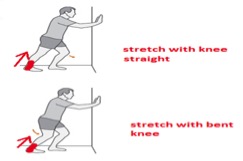
- Stationary cycle: you tin can get-go stationary bicycle in the half-dozenth week later surgery. Start stationary wheel 10 minutes a mean solar day. Gradually increment by two minutes per week till 20 minutes per week. Progress in this mode: high seat ½ circles forwards/backward (pendulum exercises) to full circles – lower seat.

- Wall squats: Identify feet at shoulder width. Take back up of a wall and squat upward to 30 degree. These are to be done at 3 angles of knee flexion. 30°, lx° and 90. Initially start with 30 degree and as you become comfortable increase the angle in the next few weeks. Hold for 10 seconds and then relax for v seconds. Do three sets of 10 repetitions.
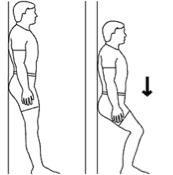
Weeks 6-12
- Increase passive range of motility of the knee to full ( 0-135°)
- Gastroc/soleus stretch
- Hamstring stretch
- Mini-squats: Squat up to 600. Don't hold the flexed position and stand up smoothly. Exercise iii sets of 10 repetitions.

- Hamstring curl (0-90°) against resistance: You can use rubberband/thera ring to exercise these exercises as shown in the picture below. Hold a chair or wall to support yourself. Thera bands come in unlike colours and their forcefulness increase in this order: Yellow- cherry-dark-green- blueish- black –silver –gold.
And so yous get-go with xanthous colour and gradually move on to gold. Echo 10 times and practice information technology twice a day.
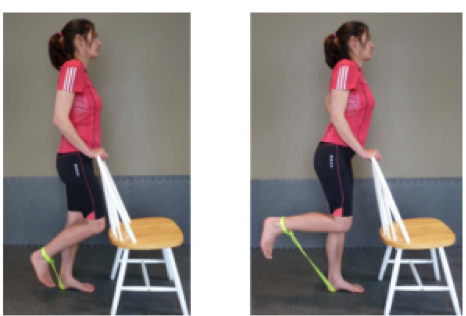
- Quadriceps strengthening exercises: This builds upwardly your quadriceps (front end muscles of thigh). Sit down on a stool and pull thera ring tied effectually talocrural joint, as shown in the movie. Gradually increase strength of thera band. Do 10 minutes a day.
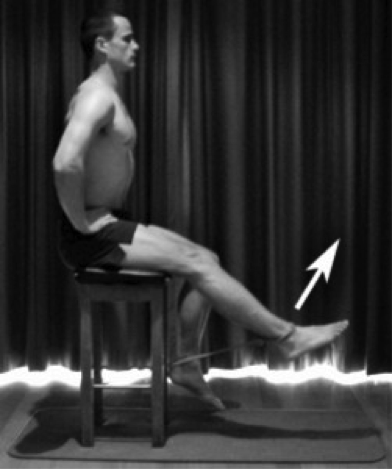
- Step-ups: Later viii weeks, yous tin do these exercises. These tin can be done forwards, backwards and from side to side. Outset with a 10cm step and gradually increase its peak to 30cm.
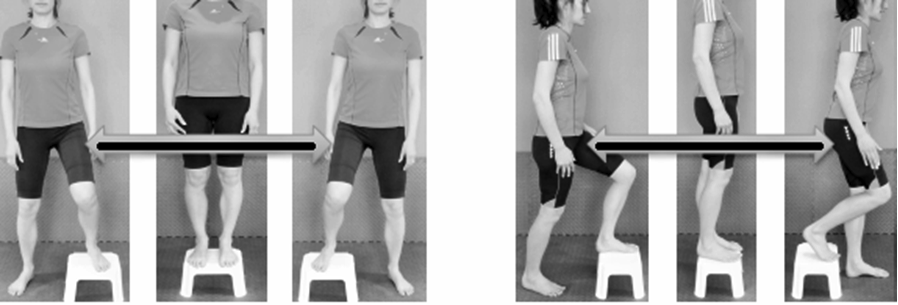
12-24 weeks: Go on doing all stretching and strengthening exercises. You should start residue training now.
– Single leg toe raises: Concur for five-10 seconds and exercise two sets of x repetitions.
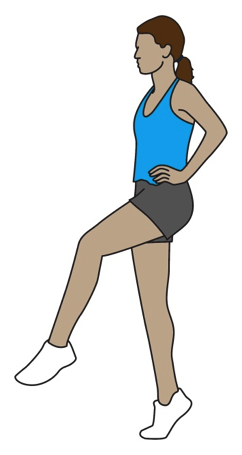
– Unmarried leg balance, optics closed: Concord for 5-10 seconds and practice ii sets of 10 repetitions.
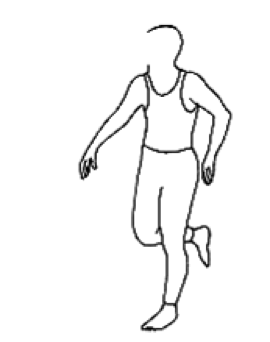
– Single leg remainder with diverse positions of head, arm and torso: Hold for v-10 seconds and do two sets of 10 repetitions.
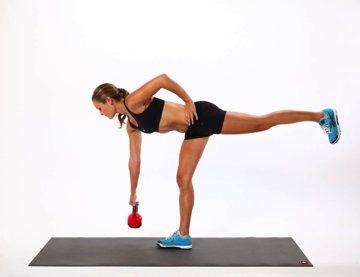
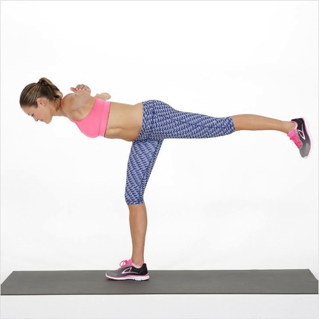
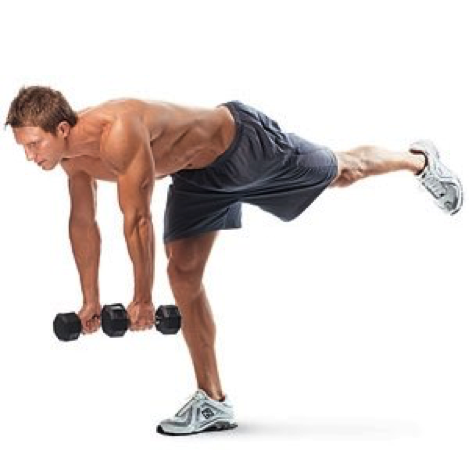
24 Weeks on wards:
Agility Drills: Agility is one's power to change management or position as quickly and effectively as possible. This is very important need during sport activity. This gives confidence to get back to sports once again and likewise help prevent re-injuries. Following are a few uncomplicated agility drills:
- Astern running: This is an effective drill specially for sports requiring force and endurance of the gluteal (buttock) and calf muscle (leg) groups. Kickoff at dull speed and gradually increase the speed. Run for fifty-lx meters and do 5-10 repetitions.
- High Knee joint Drills
While running lift knees as high every bit possible. Run for 30 seconds. Repeat two times a twenty-four hour period.
- Vertical Jumping
Stand up with your feet at a shoulder distance and bend your hip, genu and ankles until knee are flexed to 90 degrees. Now jump as high as you tin can. Land gently with knees slightly bent. Repeat 15 – 20 times.
- Carioca
During carioca drill you lot move sideways at fast speed or run sideways. Motility your correct human foot crossing front of your body and to side of left foot. Then move left human foot to side of right foot. Now move right foot crossing behind the body and to side of left foot. Thus with every step you move sideways. Move/run to thirty-40 meters.
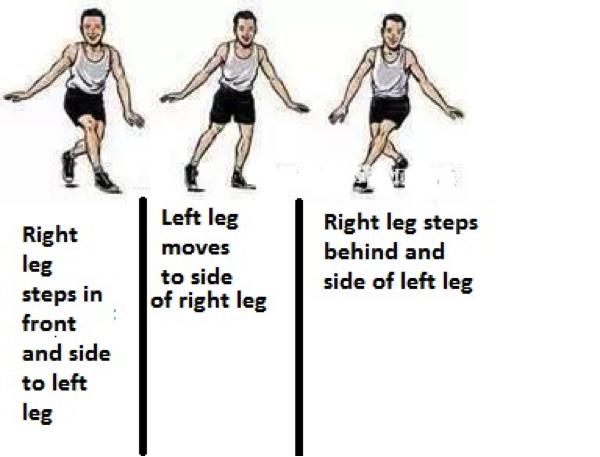
Cutting Drills
- Run and Cut
Run at moderate speed for 10-15 meters straight, plant on the correct leg and turn to change direction to left then run again. Echo fifteen-20 times.
- Effigy of Eight drill
Run a figure of eight pattern at moderate speed for 30-twoscore meters. Repeat information technology for xv times. Gradually reduce the size of "8" and increase your speed every bit yous progress. It is very helpful for developing "run and cut" skills in field sports.
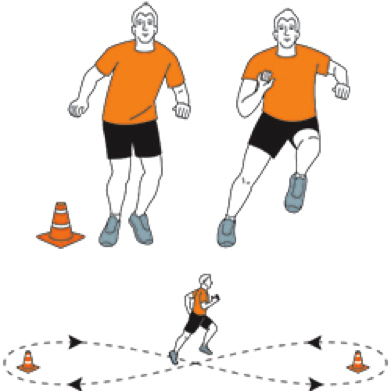
Advanced weight grooming and sports specific drills are brash to maintain a
higher level of competition.
Almost THE AUTHOR
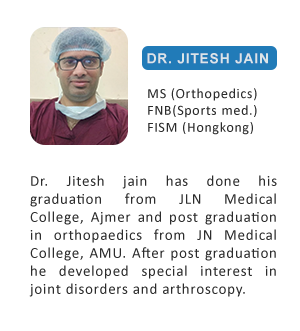
TESTIMONIAL

मेरा दाए पैर में चोट लगने के कारण टेढ़ा हो गया था जिसकी वजह से मुझे चलने में भी परेशानी हो रही थी. डॉ जितेश ने ऑपरेशन कर के इसे सीधा किया. में बिलकुल ठीक हूँ .

मेरी बेटी के घुटने में इन्फेक्शन होने के कारण वो दर्द की वजह से सो भी नहीं पाती थी. डॉ जितेश ने ऑपरेशन कर के इसे ठीक किया. बहुत धन्यवाद।

I recall that Dr. Jain came out from his clinic to see my mother because my mother was not able walk a single stride. He did total knee replacement on both side and now my mother is walking without assist.
OPENING HOURS
| Monday – Friday | 17:00 – 20:00 |
| Dominicus | OFF |
+91-7357406805
Clinic LOCATION
OUR SPECIALITIES
ACL Reconstruction is a surgical process to reconstruct the ligament in the middle of your knee in order to restore its office after an injury.
Arthroscopic surgeries are primal hole surgeries for joint disorders. They offering less infirmary stay and speedy recovery.
A painful injury where the upper arm os dislocates out of its normal position with meaning harm to the surrounding soft tissues.
A mutual sports injury which usually happens over fourth dimension from normal wear and tear of muscles and tendons.
A surgical procedure that involves replacing a damaged, worn or diseased knee with an artificial articulation to restore knee's movement.
We offer latest arthroscopic and minimally invasive single and double row rotator cuff repair in cases of rotator cuff tear.
Make An Appointment
Schedule an appointment with Dr. Jitesh to become correct diagnosis and cure for your ailment. Someone from our squad will get in touch with yous.
Source: https://ligamentsandjoints.com/exercises-after-meniscus-repair/
Posted by: muellerpory1963.blogspot.com


0 Response to "Should You Do Wall Sits If You Had Minicus Repair"
Post a Comment